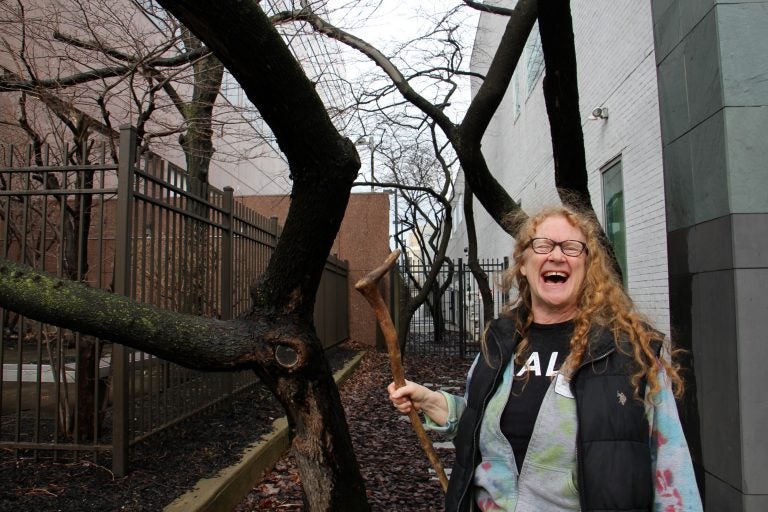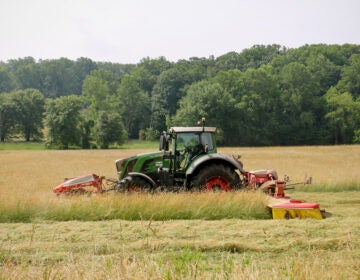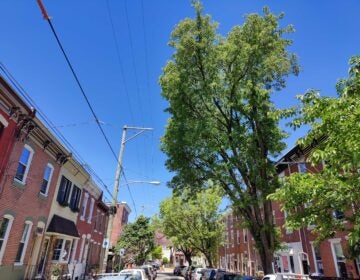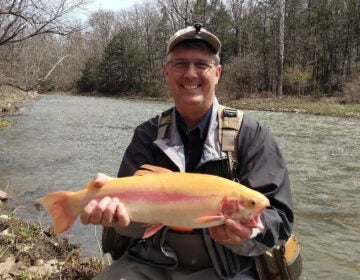Exulting in Philly’s great treasure of blossoming trees
Pennsylvania Horticultural Society educator, Sally McCabe talks the timeline of trees as they get ready to burst into blossom.
Listen 6:09
This Eastern redbud tree outside WHYY studios will bloom in a few weeks, and that thought delights Sally McCabe, associate director of community education at the Pennsylvania Horticultural Society. (Emma Lee/WHYY)
We are fortunate to live in the Philadelphia region, home to so many flowering trees, which are waking up from a long winter’s nap. Now through May, get ready for nature’s show of shows.
Morning Edition host Jennifer Lynn gets a preview from Sally McCabe, associate director of community education at the Pennsylvania Horticultural Society.
What kind of trees is the region known for, Sally?
We’re famous for our cherry trees. Even though D.C. uses them as a claim to fame, we have magnificent cherry blossoms along the drives. My personal favorite is the Polonius. The Empress trees, really big majestic trees with the purple blossoms … they get the purple flowers that look like orchids.
And they grow along train tracks, I hear.
They are desperation trees. They grow out of the cracks of buildings. They’ll grow out a of a rain spout, but they are so beautiful.
I think they’re from China.
They are from China. The nuts — they’re not nuts — but they are hard shells with lots of tiny seeds inside. They use them as packing material, so they’re like the peanuts of the colonial world, the Styrofoam peanuts.
The best ones are the ones in Logan Circle. They were planted originally – I won’t even make up that I knew the date – but they were big, and they were beautiful. And then they were declining. When the Horticultural Society took over the maintenance of the circle, they cut the trees down. Before that happened, one of our horticulturists on staff — the legend goes — they saw from I-95 in a distance a nursery that had the trees in full bloom. Little, little tiny trees. They pulled off and went and found them and found out they were offspring of the original trees from Logan Circle. So we were able, when we cut those trees, to replace them with descendants, which is a really exciting thing. The replacement trees are now big enough to make an impact.
What is the purpose of a tree blossom?
It’s all about the show. It’s all about sex. The trees are pumping out those blossoms to get the attention of the pollinators that are going to make sure that they have descendants for eventually replacing them, to make new trees. So they put the flowers out generally before the leaves even show up. So you get maximum impact visually.
Well, let’s look at sort of the estimated windows of blossoming trees. As you said, we’re known for our cherry trees, especially down along the river drives. When would they start?
They’re going to start if we get a nice 70-degree day. It’ll just arrive unexpectedly. I would guess in about two weeks they’re going to start.
What about some fruit trees? We have Callery pear, the flowering pear
We’re trying to plant less of them in the city because … they pop out early. They have beautiful white blossoms, and some of them are quite large. The problem is that if we get a late snow, they have really weak branching. Heavy snow on the petals just shatters the trees. We’ve had that happen in recent years.
And do they come before the cherry trees?
Neck and neck.
All right. And then there is a tree, I think it’s called the redbud tree?
Oh yeah.
I see them, and it looks like the buds are coming right out of the bark. It’s really tight.
You have one right out front [of WHYY], and we just looked at it, and all the buds are starting to pop. They don’t even need a branch. They come right off the trunk.
And it’s a really bright pink.
It’s a bright pink, almost a purple. They’re a couple of weeks away yet.
So Philly has two kinds of cherries. There is the kind that is along the drives.
Those are the Kwanzans.
And then there’s the Okame?
Okame. If you look at the flowers, they’re very similar to the redbuds in color. They’re the pink trees that you see right now. We don’t see groves of those. We’ve been planting those as street trees because they’re lovely, and they’re a nice tree that generally will fit under a wire.
What about Magnolia?
Magnolias are coming soon. We can start watching for them after April 15. And the hard part of those is I used to have one right next to my house, and I was horribly allergic to the pollen. And so we would pray for a late frost. If a frost would come, it would wipe out the blossoms and allergies would be fine.
Is there any exotic tree in Philadelphia that we should keep our eyes open for?
It’s not an exotic thing, but it’s a wonderful thing. We’ve resurrected the Franklinia, which was one of the early trees discovered by [the botanist] John Bartram in the 1700s. Bartram’s Garden had some specimens, and they found some still growing in other places and started to reproduce them. They are similar to a Magnolia, but they’re a smaller tree. It’s exciting because it’s a fairly new thing, and yet it’s a really old thing.
You’re winning a national award. Tell me about it.
It was the Jane L.Taylor Award through the American Horticultural Society’s Great Gardeners. It was for work that we’ve done trying to bring more children into horticulture. Although I’m a bad gardener myself, I’ll tell you my favorite thing is working with kids, building using tools, getting your hands dirty, playing with worms. Just getting that spark while the kids are little.
WHYY is your source for fact-based, in-depth journalism and information. As a nonprofit organization, we rely on financial support from readers like you. Please give today.





